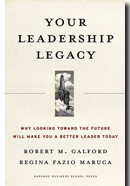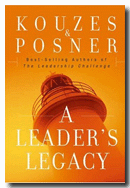Issue 21: In This Issue:
- Your Leadership Legacy
- A Leader's Legacy
Your Leadership Legacy
By Robert Galford & Regina Fazio Maruca 
Although the term “legacy” is not generally used when looking forward into the future, that’s exactly what Galford and Maruca believe a leader should be doing.
It's Never Too Early
They maintain that it is never too early to think about the kind of long term impact you’ll have on your organization; that it is never too early to think about what people will think, say, or do, after your tenure as a leader has ended, as a result of having worked for you.
Legacy as a Catalyst for Action
Their central idea is that one’s desired leadership legacy should be a catalyst for action rather than a result considered after the fact. Being intentional about your desired long-term impact helps you both in the short run and in the long run.
Their book offers lessons that have emerged from their experiences working with and talking to CEOs, professionals and executives from a wide range of organizations, including Fortune 100 companies, global nonprofit entities, large banks and small design firms.
Legacy as a Forward Thinking Tool
They advocate using a legacy as a forward-thinking tool and have spent considerable effort honing the definition of what a leadership legacy should be. They found that looking forward, people wanted to achieve success in organizational or performance terms; but in looking back, they wanted to know that their efforts were seen and felt in a positive way by the individuals they worked with directly and indirectly.
The authors quote one executive who summed up:
“…The issue is that there isn’t an opportunity to connect personal aspirations with the day-to-day work of running the company. It’s like there’s a way to think about long-term performance, on the company level. And in the course of ‘performing‘, there are these opportunities to make a difference on a personal level. But there’s a divide; there’s no way to connect the two.”
Bridging the Divide
In practical terms, the book’s first goal is to bridge this divide. The structure that Galford and Maruca propose – what they call legacy thinking – makes the link between daily behaviour and long term impact explicit. Legacy thinking is a tool through which leaders can filter and assess their decisions. It provides the kind of perspective that barely makes it to the table in the course of daily pressures of running an organization. It also serves as a powerful check to help leaders ensure that their priorities – personal and organizational – are reflected in their actions.
Helping to Leave a Positive Legacy
The book’s second goal is to help great leaders leave positive legacies. They point out that it is all too possible for leaders to produce positive results in terms of the organization’s success but leave negative leadership legacies when viewed from a personal, peer or direct report perspective.
Benefits of Legacy Thinking
The authors list a number of things that legacy thinking can do for you as a leader:
- If you’re the kind of leader who tries to take on too much, legacy thinking reveals to you where your influence is actually having a lasting effect and where it is not. Thinking about leadership in the context of your legacy helps you to establish – and re-establish – priorities.
- Legacy thinking locates you in the history of your company; a benefit that can be particularly valuable for early leaders. You can locate yourself along a timeline for the company and begin to see the scope of your work in a different way. You can see how the way you, or the person you just hired, is going to work has already been shaped or framed to an extent by the people who came before.
- Legacy thinking helps you to recognize when you are wasting your time in a given senior management slot and also helps you identify when it is time to make a move.
- Legacy thinking also helps you put the important task of succession planning in perspective. By revealing your natural role (which has little to do with the requisite responsibilities of the position of leader), it helps you let go and even helps you seed the success of your successor.
- Perhaps most importantly legacy thinking tempers your necessary focus on the tasks at hand with a sense of greater purpose. It embeds your work with meaning that goes beyond one more sales visit, or one more management meeting, or one more deal.
A Practical Definition
In order to approach the issue of leadership legacy in practical terms, Galford and Maruca define it as follows:
"a leadership legacy is the impact you have (ie the scope and scale of your influence on others) over the duration of your time in a given position or at a given company, all colored by the judgment, or guiding principles, that you apply most consistently to your decisions."
Impact and Duration
Using this definition, they then dedicate three chapters to a leader’s impact:
- Where your impact is felt and how you can identify the ways your behaviour is already having an effect.
- A comparison of a leader’s natural roles with his or her position and job responsibilities
- How to set the specs for your desired impact by writing a legacy statement, which they consider to be the heart of the book
They then follow up with two chapters on a leader’s legacy which focus on ways a leader can pressure test a desired legacy and describe actionable steps.
Judgment
The final two chapters are dedicated to a leader’s judgment and address such issues as:
- What pitfalls stand in the way of leaving a desired legacy?
- Which battles should you fight and which avoid?
- What are realistic expectations for achieving a legacy?
Leadership legacies cannot be neatly specified or described. They can’t be measured for individuals by using a standard benchmark. But they can be deliberately pursued.
An Effective Guide Supported with Learning Examples
Galford and Maruca’s definition provides a common approach that grounds the concept and allows leaders to plan and measure their efforts to the fullest extent possible. They provide a guide to follow in writing your legacy statement and they fill the book with case studies that demonstrate the relevance of the issue in the real world.
To purchase 'Your Leadership Legacy' click this link to get it from: 
A Leader’s Legacy
By James Kouzes & Barry Posner 
Kouzes and Posner point out that thinking about our legacies requires us to move beyond short term definitions of success; that legacies encompass past, present and future and when we are pondering our legacies we are forced to consider where we’ve been, where we are now and where we are going.
Like Galford and Maruca (see the review of ‘Your Leadership Legacy’ in this newsletter), they maintain that thinking about your legacy will enable you to leave your organization and the world a better place than you found it.
‘A Leader’s Legacy’ is comprised of twenty-one essays grouped into four sections:
- Significance
- Relationships
- Aspirations
- Courage
Significance
Kouzes and Posner start the section on Significance with the wisdom that when we move on, people do not remember us for what we do for ourselves but, rather, what we do for them. They state that one of the grave responsibilities of leaders is to make sure that those in our care live lives not only of success but also of significance.
The authors echo the seminal work of Robert Greenleaf in their position that leaders who see their role as serving others leave the most lasting legacies.
Their greatest achievements are the triumphs of those they serve. Knowing they have made a difference in others’ lives is what motivates their own, giving leaders the strength to endure the hardships, struggles and inevitable sacrifices required to achieve great things.
Also in the essays on significance they deal with a variety of other issues:
- Teaching is one way of serving and the best leaders are also teachers
- Learning requires feedback but one of the most glaring leadership shortcomings is that most leaders don’t ask “How am I doing?”
- The most important leader in any organization is not the CEO but the one we see most often
- A leader’s legacy is the legacy of many and none of those who contribute to making a difference want to be taken for granted. Everyone wants to be significant.
Relationships
Kouzes and Posner point out that leadership is a relationship between those who aspire to lead and those who choose to follow. No matter how much formal power and authority our positions give us, we’ll only leave a lasting legacy if others want to be in that relationship with us.
Consequently, leaders should want to be liked - but that does not mean “going along to get along”. It does mean being flexible with style but firm on standards.
Leaders need to understand that trust is a mandatory requirement and that it cannot be taken for granted. We have to constantly work at building it, nurturing it and sustaining it. And finally leaders need to set their people free to decide things for themselves and shape their own destiny.
Aspirations
In this section, the authors underline that people commit to causes not to plans and that a lasting legacy is built on a firm foundation of principles and purpose. They echo a number of writers such as Bill George (Authentic Leadership) on the importance of authenticity, self-development and finding your own authentic voice.
The requirement for leaders to be forward looking is well established. Yet Kouzes and Posner make a surprising assertion when they state that being forward looking is the skill at which leaders are the most inept.
And in terms of the future, leaders must understand that leadership isn’t about selling your vision; it’s about articulating the people’s vision. The best leaders turn their followers into leaders and are willing to turn themselves into followers.
Courage
Leaving a legacy is all about making a difference and we can only make a difference when we take stands. If you are going to leave a legacy of lasting significance, it will be the result of acting courageously. You can’t plan to be courageous, but you can choose to act that way.
We also have to remain vigilant in reining our own sense of self-importance and we must have the humility and grace to admit that we depend on others as much as they depend on us.
A Worthwhile Legacy
The twenty one essays that make up this book are brief and to the point. They represent brand new experiences and stories as well as new variations on familiar themes. They will stimulate and challenge you and help you to leave your organization and the world a better place than you found it – which would definitely be a worthwhile legacy.
To purchase 'A Leader's Legacy' click this link to get it from: 